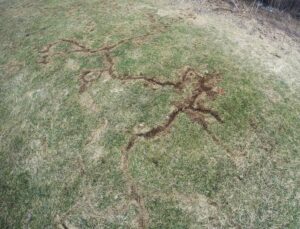Table of Contents
ToggleLast Updated on May 4, 2025
What is a Vole?
Have you ever heard of a vole? Don’t worry, although this rodent is common, many people have never heard of them. Often referred to as meadow or field mice, these small rodents are generally dark brown or gray in color and only around five to eight inches in length, while their body is frequently more robust than a mouse.

Voles construct runways at the lawn surface with numerous burrow openings that typically stem from shrub beds or wood lines. In some cases, the network of runways can be extensive, covering a significant area of a property. While these trails can be found any time of the year, they are most often discovered as snow begins to melt in the early spring. Under snow cover and hidden from predators, voles will venture further into open areas foraging for food. Following a winter with persistent snow coverage for long periods, damage tends to be worse.
Distinguishing a Vole from a Mouse
Prior to protecting your property and getting rid of voles, it is important to be able to identify the mouse-like rodent as it differs from other rodents like moles, mice and rats. Voles are almost always mistaken for mice and one of the best ways to differentiate the rodents is by tail length. Mice have long tails that are equal to about half of their body length while voles’ tails are shorter. Their tail has thin hair and is darker on the upper side than the lower side. Another distinguishing characteristic includes their round head shape and blunt snout. The voles’ eyes are very small and black, and their ears are covered by fur.
There are several species of voles that are native to our area and eat a wide variety of plants, most frequently grasses and glasslike plants. In the late summer and fall they store seeds, tubers, bulbs, and rhizomes. They primarily eat bark in the fall and winter, and will also eat grain crops, especially when populations are high. Occasionally food items include snails, insects and animal remains. Voles are active day and night year-round, with peak activity being from dawn to dusk. Their home range is usually a quarter of an acre or less, but this range varies with season, population density, habitat and food supply.
Most importantly, voles need ground cover to survive and therefore avoid open ground areas. Cleared spaces as narrow as 10 inches inhibit their movements.
Although voles breed throughout the year, breeding is most common during spring and summer months. Generally, they have one to five litters per year and litter sizes range from one to 11 young and the gestation period is about 21 days. Further, the young are weaned by the time they are 21 days old, and females are sexually active in 35 to 40 days. Voles have short life spans that generally range from two to 16 months.
Getting Rid of Voles
Unfortunately, the eradication of voles is not easy for homeowners, nor is it completely necessary. However, if getting rid of voles is a priority, repellents or chemical lures can be effective in some cases but cannot provide one hundred percent control. Additionally, these chemical repellants should be used with caution due to subsequent effects on certain birds and other small mammals like chipmunks and squirrels.
Traditional mmousetraps(a ‘snap trap’) baited with food items and placed near the runways can also be effective in catching some voles. Nevertheless, this method does not reduce the vole population numbers significantly.
Protecting plants from voles in shrub beds can be done with a fence buried three to six inches below the soil surface and bent outward into an L shape. Above ground, the fence should be from four to 12 inches tall. Use non-rusting, one quarter inch mesh. Hardware cloth works well for this purpose.
Removing weeds, mulch and other crop litter around gardens will help protect plants. Create a bare border space around your garden or dig a trench twelve inches in depth and wide enough to step over easily to discourage voles. To learn more about weed control in mulch beds, check out helpful tips about applying pre-emergent weed control.
While getting rid of voles may be difficult, the damaged grass and plants can grow back! Once the grass begins actively growing, vole trails become less obvious. Spring fertilization helps speed the lawn’s recovery; however, minor touch up seeding may be necessary to further correct the issue.
Conclusion
One key takeaway about voles is that they prefer a location with cover. Expect to have less vole damage during mild winters with short periods of snow cover. If you are in our service area and have any questions about getting rid of voles, please feel free to call our office at 908-281-7888.

